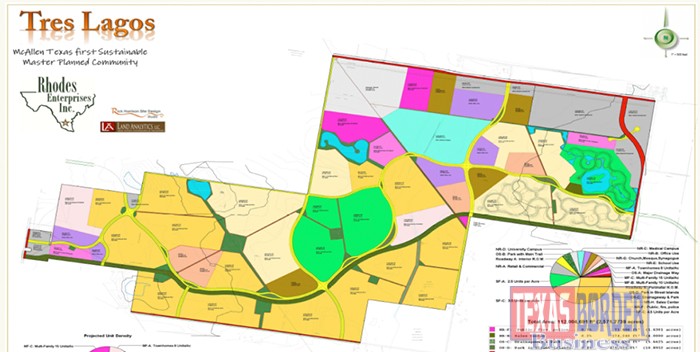
Texas Border Business
McALLEN – The McAllen City Commission approved a $2 billion multi-faceted plan that would develop a large area of far north McAllen with residential, commercial and government subdivisions using sustainable and smart technology.
To launch the mega 2,571-acre master planned development; commissioners gave the nod at Monday’s March 10 meeting approving an agreement between the City and Rhodes Enterprises (Tres Lagos developer) for Tax Increment Reinvestment Zone (TIRZ) No. 1, and adopted an interlocal agreement between the City and Hidalgo County for participation in the TIRZ.
“Tres Lagos is the first TIRZ approved in McAllen. We are very excited that this unique, master planned development will become a reality in our great city. We anticipate great success in our growth corridor to the northwest of McAllen,” said City Manager Roel “Roy” Rodriguez, P.E.
Rhodes Enterprises will invest over $232 million in public infrastructure to grow the area into a great place to live, work and play for generations to come. Private investment in construction of homes and businesses is projected to be over $2 billion over the 30-year build-out period with an estimated creation of 8,000 jobs.
Project highlights include:
* Proposed interface with the City’s police and fire departments for increased response time and a higher degree of security.
* Development will be the first in the region to provide Fiber-to-the-Home (FTTH) and bundled services (High-speed Internet Access, Community WiFi, Alarm Monitoring, Video Surveillance, IPTV, IP Telephony, and Smart Home Technology) to 6,793 residential homes.
* Community WiFi access designed for gigabyte capability for ultimate upload/download speeds throughout the Development to include residential subdivisions and parks.
Assistant City Manager Michelle Leftwich said the city will collect 100 percent of the taxes due to the City of McAllen every year and twenty percent of those taxes will be deposited into the city’s general fund like all other property taxes.
Eighty percent of those taxes go into a TIRZ fund that can be used to repay the city for the tie-in infrastructure that is being built (fiber line to the southernmost corner of the development and water reuse line to the sewer plant) and other public infrastructure the developer may build and dedicate to the public in the future. Another incentive is that the county will also place a portion of their collected taxes (77 percent) into the TIRZ fund for city infrastructure.
“We have worked hard to ensure the City’s interests are protected and that the minimal investments we are making are paid back first as the area transforms and the tax increment grows for this area and the city as a whole,” Leftwich said.
The next steps include the county approving the interlocal agreement and the City creation of a Public Improvement District for the long-term administration and maintenance of the development.














